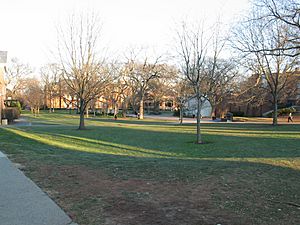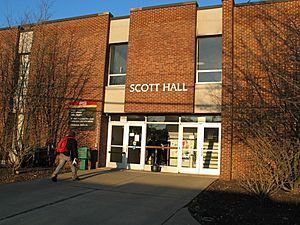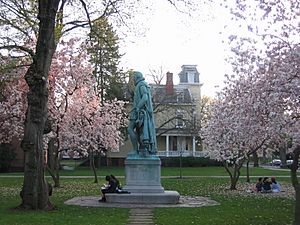Voorhees Mall facts for kids
Voorhees Mall is a large, grassy area with many trees at Rutgers University in New Brunswick, New Jersey. It's like a big park on the university's College Avenue Campus. Many old and important buildings of the university are located around this mall.
The mall is surrounded by Hamilton Street, George Street, College Avenue, and Seminary Place. Right next to it is the New Brunswick Theological Seminary, which has a long history with Rutgers. Also nearby is the Old Queens block, which is a very important part of the university.
This open space was created when a city street called Bleecker Place was closed. It was named Voorhees Mall after Ralph and Elizabeth Rodman Voorhees, who gave generous donations to Rutgers. One of their gifts helped build the university's first library building, which is now called Voorhees Hall.
Long ago, the yearly graduation ceremonies for Rutgers College were held at Voorhees Mall.
Contents
Buildings Around Voorhees Mall
Riverstede (1868)
Riverstede is an old house built in 1868 by Professor George Hammell Cook. He was a very important person, and the Cook Campus at Rutgers is named after him. This house was later home to William H. S. Demarest, who was the eleventh President of Rutgers University.
Today, Riverstede helps students find information about the campus. In the past, it was used for many different things, like a club, a student house, and even a place for career services.
New Jersey Hall (1889)
New Jersey Hall was built with money from the New Jersey state government. It was meant to be an "Agricultural Hall" and first held the Chemistry and Biology departments. Today, this building is mainly used for offices. It houses the university's Economics Department.
There have been talks about renaming New Jersey Hall after Milton Friedman. He won a Nobel Prize and graduated from Rutgers College in 1932.
Ballantine Gymnasium (1894-1931)
Ballantine Hall was a gymnasium that was mostly destroyed by a fire in the 1930s. The back part of the building stayed standing. Later, when a new gym was built, Ballantine Hall was used for classrooms.
Today, the Jane Voorhees Zimmerli Art Museum has expanded over where Ballantine Gym used to be. You can still see parts of the old building's front in the parking lot behind the art museum.
Voorhees Hall (1903)
Voorhees Hall was originally built to be the main library for Rutgers College. It is named after Ralph and Elizabeth Rodman Voorhees, who were very generous to the university. The main library later moved to the Archibald S. Alexander Library.
Voorhees Hall then became the University Art Gallery, which grew into the Jane Voorhees Zimmerli Art Museum in 1983. Now, it is home to the university's Department of Art History and the Art History Library. The library was made bigger in 2002.
Murray Hall (1909)
Murray Hall was first built for the College of Engineering. It was designed by two Rutgers graduates. Part of the money for the building came from Andrew Carnegie, a famous businessman.
The hall is named after David Murray, who was a professor and trustee at Rutgers. He helped Rutgers become a "land-grant college," which meant it received special support from the government. Today, Murray Hall has classrooms and is home to the university's English Department. The College of Engineering has since moved to a different campus.
Milledoler Hall (1910)
Milledoler Hall was first called the Chemistry Building. It is named after Reverend Philip Milledoler. He was a professor and the fifth President of Rutgers College from 1825 to 1840. Reverend Milledoler was also the person who suggested changing the college's name from Queen's College to Rutgers College in 1825. He wanted to honor Colonel Henry Rutgers, a hero from the Revolutionary War.
Today, Milledoler Hall holds several administrative offices for Rutgers College, including the Dean's Office, and one large lecture hall.
Graduate School of Education
The Graduate School of Education was originally part of the Graduate School-New Brunswick, which started in 1876. It is one of the oldest graduate schools in the country. The Graduate School of Education became its own separate school in 1923. Its current building was built in 1961. The building has a unique design, supported by stilts at one end.
School of Social Work
The Rutgers School of Social Work building was first built in 1922 for the School of Ceramics. The building uses many ceramic materials in its design, donated by New Jersey's ceramics industry.
The third floor has a large, beautiful fireplace. The floor of that room is made entirely of artistic tiles. The Ceramic Engineering Department moved to a different campus in 1963.
Van Dyck Hall (1928)
Van Dyck Hall was built in 1928 and is named after Francis C. Van Dyck, who was the first dean of Rutgers College. It was originally part of the Rutgers Scientific School and housed the Physics department. Today, Van Dyck Hall has classrooms and is home to the university's Department of History.
Ford Hall
Ford Hall was the second dormitory (student living building) on campus, built in 1915. It is the oldest dorm still used for students today. Underneath the dorm, there is an old tunnel that was dug in the 1700s to mine copper. It is believed this tunnel was used to help runaway slaves as part of the Underground Railroad and to smuggle alcohol during Prohibition.
Today, Ford Hall is a dorm for graduate students. It is named after John U. Ford, a university trustee and businessman in the rubber industry. The building was designed by a famous architect named Bertram Goodhue.
Scott Hall
Scott Hall is a modern building constructed in 1963. It is named after Austin Scott, who was the tenth President of Rutgers University and a history professor. Scott Hall is one of the main classroom buildings on campus, along with Murray Hall and others. Its large auditoriums are often used for movies, plays, and other events, as well as classes.
The William the Silent Statue
A doctor and biologist named Fenton B. Turck, with help from a Rutgers alumnus named Leonor F. Loree, secretly donated a statue of Prince William the Silent (1533–1584). Prince William was a leader from the Dutch who fought for their freedom from Spain.
Dr. Turck, who had Dutch family, wanted to give the statue to Rutgers to show the university's Dutch beginnings. He kept the statue in his lab for eight years before it was shown to the public on Voorhees Mall on June 9, 1928. There's a fun student tradition that says the statue whistles when a virgin walks by, which is why it's called "silent."
This statue is the only copy of the original statue that stands in The Hague, a city in the Netherlands.




